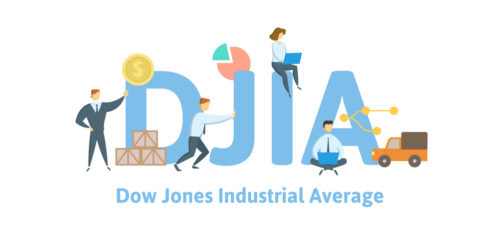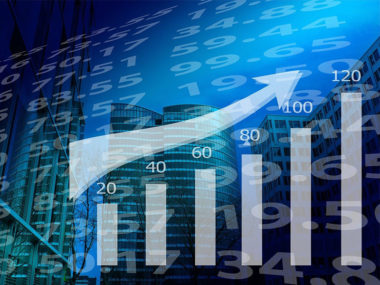The Dow Jones Industrial Average (DJIA) is an index that contains 30 of the largest blue-chip companies in the United States. These are not only among the largest companies in the country, but their shares also happen to be among the most widely held by investors.
Like other indexes, such as the NASDAQ Composite or S&P 500, investors and economists use the DJIA as a representative for the broader stock market. In some contexts, the index gets referenced as an indicator of the overall economic health of the country.
Investors use the Dow to help make buy and sell decisions for stocks.
The Dow, as investors and market watchers call it, is unique among most other major indexes because it uses a price-weighted average of its stocks. The index has used its formula since its namesakes, Charles Dow and Edward Jones, started it in 1896.
Table of Contents
What Is the Difference Between Dow Jones and the DJIA?
Dow Jones actually refers to Dow Jones and Company. Charles Dow and Edward Jones were journalists, and their company founded one of the world’s most famous financial newspapers, the Wall Street Journal. Charles Dow first published the Dow Jones Industrial Average in 1896 using 12 companies for his calculations. Though the number of stocks has changed since then, the Dow is still a price-weighted index.
In the finance industry and on Wall Street, insiders often refer to the index, which is officially the Dow Jones Industrial Average, as the DJIA, Dow Jones, or, simply, “the Dow.”
The Dow Jones also continues to publish the Wall Street Journal.
What Is a Price-Weighted Index?
The method for calculating the DJIA has changed slightly over the years, but it remains a price-weighted index.
When Charles Dow took the original 12 stocks, he added the closing price of each stock and then divided it by 12.
Today, each of the 30 members of the Dow contributes its price to the equation. Other factors, such as market capitalization, do not play a role in calculating the equation. The higher the price of a stock in the Dow, the more weight it has on the overall index average. Stocks that have very high prices, such as Chipotle (CMG) or Alphabet Inc. (GOOGL), are not part of the DJIA because their price tag would mean that they would have too much of an impact on the overall average.
Another example of a price-weighted index is Japan’s Nikkei 225.
How Is the DJIA Calculated?
The Dow Jones gets calculated by adding the price of all the stocks in the index and dividing that sum by a unique divisor. Initially, this divisor was simply the number of companies in the index (12). When Charles Dow added the prices for the first time, the sum came to 491.28. He then divided that by 12 and came up with 40.94, which was the first average for the index.
Today’s calculations are more complex. The Dow uses a divisor that takes into account stock splits and dividends. Still, though, the equation remains quite simple. The average in the DJIA is the total price of all stocks in the index divided by the current divisor.
Dow Divisor
The Dow divisor changes whenever there is a dividend or stock split. The goal is to find a divisor that provides the same results as before the stock split occurred. After all, a stock got split, but it did not change in value, so the people behind the Dow want to make sure these changes do not impact the accuracy of the index.
If a $40 stock splits, each share would be worth $20. This change would affect the index because it would change the total price of the 30 stocks. To negate this effect, the Dow takes the new total with the split stock and divides it by the index average before the stock split. This calculation leads to a dividend that should provide a comparable average to the pre-split dividend.
A simple example demonstrates how to arrive at a new Dow dividend. Charles Dow’s original index had a sum of 491.28, which, when divided by the 12 initial stocks, came to an average of 40.94.
If a stock got split at $40, one share would be $20, and the new total for all 12 stocks would be 471.28. You would divide the new total (471.28) by the old average (40.94) to get a new divisor. In this example, the new divisor would be 11.51.
How the DJIA Has Changed
The Dow has changed over the years. It started with 12 companies and expanded to 30 in 1928. The Wall Street Journal selects stocks that they think will accurately mirror the state of the overall markets. The companies on the index can change, but the number of companies remains the same today as it was in 1928. Between 1997 and 1999, theJournal swapped a total of eight companies.
The “Dow 30”
Today, 30 stocks make up the DJIA. They come from all major sectors of the U.S. economy, and all are major players in their specific industry.
- 3M (NYSE:MMM) — Added in 1976;
- American Express (NYSE:AXP) — 1982;
- Apple (NASDAQ:AAPL) — 2015;
- Boeing (NYSE:BA) — 1987;
- Caterpillar (NYSE:CAT) — 1991;
- Chevron (NYSE:CVX) — 2008;
- Cisco (NASDAQ:CSCO) — 2009;
- Coca-Cola (NYSE:KO) — 1987;
- The Walt Disney Company (NYSE:DIS) — 1991;
- DowDuPont (NYSEMKT:DD) — 2017;
- ExxonMobil (NYSE:XOM) — 1928;
- General Electric (NYSE:GE) — 1907;
- Goldman Sachs (NYSE:GS) — 2013;
- The Home Depot (NYSE:HD) — 1999;
- IBM (NYSE:IBM) — 1979;
- Intel (NASDAQ:INTC) — 1999;
- Johnson & Johnson (NYSE:JNJ) — 1997;
- JPMorgan Chase (NYSE:JPM) — 1991;
- McDonald’s (NYSE:MCD) — 1985;
- Merck (NYSE:MRK) — 1979;
- Microsoft (NASDAQ:MSFT) — 1999;
- Nike (NYSE:NKE) — 2013;
- Pfizer (NYSE:PFE) — 2004;
- Procter & Gamble (NYSE:PG) — 1932;
- Travelers Companies (NYSE:TRV) — 2009;
- United Technologies (NYSE:UTX) — 1939;
- UnitedHealth (NYSE:UNH) — 2012;
- Verizon (NYSE:VZ) — 2004;
- Visa (NYSE:V) — 2013;
- Wal-Mart (NYSE:WMT) — 1997.
Is the DJIA a Good Standard of Measurement?
People often look at the Dow Jones Industrial Average as “the market.” When they say that the market had a good day, they mean that the Dow was higher today than it was at the close of trading yesterday.
However, the DJIA is merely an estimate. It has only 30 of the 5,000-plus stocks, which is less than 1% of all stocks traded. Despite this drawback, the Dow, more often than not, has accurately reflected overall market conditions and predicted both up and down (bull and bear) markets.
How the DJIA Is Successful
The Dow Jones would not have lasted for such a long time if it did not provide some insight into the market. The companies in the index are among the most influential in America. When the Dow shows weakness, it often comes just before market conditions change for the worse.
The DJIA has been successful at predicting these “bear markets.” Because it has mirrored overall market conditions as well as other major indices such as the NASDAQ or S&P, the Dow remains closely watched by investors, economists, and financial journalists.
Areas for Improvement of the DJIA
Criticism of the Dow revolves around two different traits. First of all, it only has 30 stocks. That is a small percentage of the more than 5,000 stocks that get traded daily on U.S markets. Other significant indices have more stocks. The S&P 500, as its name suggests, takes data from 500 companies, while the NASDAQ Composite contains more than 3,000 companies.
Critics also point to the use of a price-weighted average. They claim that a price-weighted index gives more weight to companies that have higher prices. For example, in terms of market capitalization, both Boeing and Coca-Cola are similarly-sized companies (with Coke being slightly larger). However, Boeing has a much larger influence on the DJIA because its stock price is much higher than Coca-Cola. Boeing shares currently trade at $329, while you can purchase a share of Coca Cola Company for $56.
Image Source: https://depositphotos.com/





